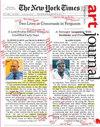When Images in Haiti Fail: The Photograph of Charlemagne Péralte
IF 0.3
3区 艺术学
0 ART
引用次数: 0
Abstract
ABSTRACT In 1919, the US Marines took a staged photograph of the recently killed insurgent Charlemagne Péralte in order to impede other oppositional fighters during the US Occupation of Haiti. Local viewers interpreted the reproduced and circulated photograph of Péralte crucified to a door as a sign of his martyrdom and strength. While scholars most often turn to Philomé Obin’s circa 1970 painting Cruxification de Charlemagne Péralte pour la Liberté to discuss the generative possibilities of the photograph, I return my attention to the photograph and the earlier context of its making, display, and distribution. Turning back to the visual field of the photograph and its moment allows for distinctive insight. Specifically, my interest lies in what happens when images in Haiti during the US Occupation failed to operate as intended by the Marines. It explores how the contours of this kind of failure become a site for reinterpretation. I privilege examples of how Haitians assert their engagement with the visual by focusing on descriptions, responses, and references to images. Doing so enlarges one’s perception of aspects of the visual that are not built, painted, or made by Haitians but, as I argue, were seen and reinterpreted by some of the country’s early twentieth-century marginalized viewers for their own benefit.当海地的图像失败:查理曼·Péralte的照片
摘要1919年,在美国占领海地期间,为了阻止其他反对派武装,美国海军陆战队拍摄了一张最近被击毙的叛乱者查理曼·Péralte的舞台照片。当地观众将复制并流传的Péralte被钉在门上的照片解读为他殉难和力量的象征。虽然学者们通常会参考菲洛梅·奥宾1970年左右的画作《查理曼大帝的残酷统治》来讨论这张照片的生成可能性,但我还是把注意力放在了这张照片及其制作、展示和分发的早期背景上。回到照片的视野和它的瞬间,可以获得独特的洞察力。具体来说,我感兴趣的是,当美国占领期间海地的图像未能按海军陆战队的意图运行时会发生什么。它探讨了这种失败的轮廓如何成为重新解释的场所。我特别列举了海地人如何通过关注描述、回应和对图像的引用来维护他们对视觉的参与。这样做扩大了人们对视觉的感知,这些视觉不是由海地人建造、绘画或制作的,但正如我所说,这些视觉是由该国20世纪初的一些边缘化观众为了自己的利益而看到和重新解释的。
本文章由计算机程序翻译,如有差异,请以英文原文为准。
求助全文
约1分钟内获得全文
求助全文

 求助内容:
求助内容: 应助结果提醒方式:
应助结果提醒方式:


